Who is a Candidate for a Hand Surgery?
A good candidate should be physically healthy and has sharp or burning pain in the thumb and/or fingers. It’s common to experience numbness and tingling sensation in your hand and arm. A good candidate for hand surgery is someone with an obvious deformity like a crooked finger or has difficulty extending or straightening a wrist and fingers. Other symptoms can include pain when moving or squeezing a hand, swelling, tenderness and stiffness.
What are the Risks?
Thousands of hand surgeries are performed each year making it a safe procedure. Possible complications include a bad reaction to anesthesia, blood clots, infection, loss of sensation or motion and poor healing.
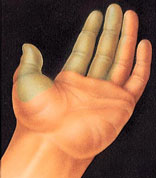
Carpal tunnel syndrome can cause tingling, numbness, or a dull ache in the shaded area shown in this illustration.
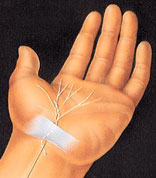
The surgeon makes an incision from the palm to the wrist, providing access to the tissue that's causing pressure on the nerve.
Initial Consultation
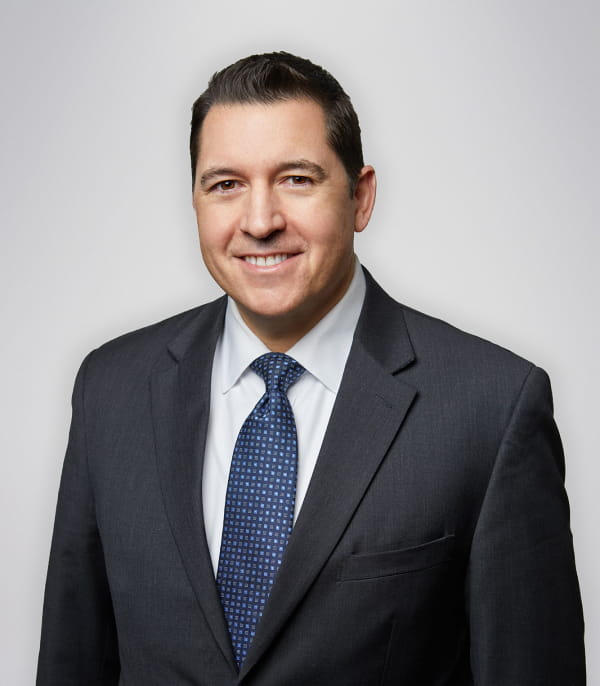
During your initial consultation, our Portland hand surgery patients will have an opportunity to ask questions about their surgery. You can express your concerns and fears about the surgery and how it may affect you in the future. Dr. Bartholomew will examine you and review your medical history before making a recommendation on the best treatment for you.
The procedure will be explained in detail, including where the surgery will be performed, the anesthesia and what surgical techniques will be used. Dr. Bartholomew will also clarify some of the possible risks and complications, your rehabilitation period and the outcome of the surgery, including functionality and appearance.

In Dupuytren's contracture, scar-like tissue in the palm pulls fingers into an abnormal position. The surgeon may make zig-zag incisions across this band of tissue, creating small skin flaps.
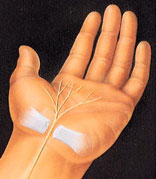
A section of tissue is cut, relieving pressure on the nerve and restoring feeling and function to the hand.
Hand Surgery Procedure
The most common hand surgeries repair injured hands on the tendons, nerves, blood vessels, and joints. Some of the techniques utilized for hand injury include grafting (the transfer of skin, bone, nerves or other tissue from a healthy part of the body to the injured area), flap surgery (moving the skin and its underlying fat, blood vessels, and muscle from a healthy part to injured spot) and transplantation (restoring accidentally amputated fingers or hands with microsurgery).
Depending on the gravity of your injuries, it may be necessary to have several surgeries over an extended period of time to repair and fix your hand. A significant degree of feeling and function is often restored to an injured hand. Keep in mind that it takes hand therapy and a few months for a full recovery.
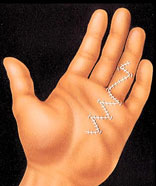
After surgery the repositioned flaps expand like an accordion, allowing freer finger motion.
Conditions that are treated with a hand surgery:
Carpal Tunnel Syndrome
Carpal Tunnel Syndrome deals with the passageway of the wrist carrying tendons and one of the hand's major nerves. The causes for the syndrome include repetitive motions of the hand, an injury, a disease like rheumatoid arthritis or fluid retention during pregnancy. Then pressure builds up on the nerves within the tunnel resulting in people feeling tingling sensations and numbness in the hand. It begins to limit and impair hand function. When anti-inflammatory medications do not relieve the problem, a hand surgery may be required.
A hand procedure involves Dr. Bartholomew making an incision from the middle of the palm to the wrist and then cutting the tissue that is putting pressure on the nerve. After surgery, a large dressing and splint are utilized to restrict motion and promote healing until the scar fades.
Rheumatoid Arthritis
Rheumatoid arthritis is an inflammation of the joints that alters the power of the hands, often causing finger joints to become deform and bent in a way that hampers movement. Some people can manage by using physical therapy to strengthen weakened areas. But many Portland hand surgery patients require surgery to repair or reconstruct part of the hand or wrist. How this works is the tissue is removed from inflamed joints or repositioning tendons leading to a meaningful improvement in the function and appearance of the hand.
Trigger Finger
Trigger finger concerns the abnormal swelling of the flexor tendon that prevents normal gliding and causes popping or locking of the finger. If the injection of corticosteroid does not help, surgery may be needed to treat this problem.
Ganglion Cysts
Ganglion cysts are bumps under the skin near the wrist or fingers that can limit activities. A surgical excision is the most effective way to remove these lesions.
Cubital Tunnel Syndrome
Cubital tunnel syndrome is the compression of the ulnar nerve at the elbow with tingling in the ring and small fingers. It leads to loss of dexterity, numbness and even nerve damage. When it reaches the advanced stage, hand surgery may be necessary.
Dupuytren's Contracture
Dupuytren's Contracture is a disorder of the skin with thick tissue forming on the palm side of the hand. It may extend into the fingers and restrict motion. Dupuytren’s Contracture usually develops in mid-life with cause unknown. In the surgical procedure, the bands of thicker tissue are cut and separated to free the tendons and allow for better finger movement.
It is a delicate surgery because the nerves (of the hand and fingers) are restricted and tight in the abnormal tissue. Skin grafts may be required. In conjunction with physical therapy, significant improvement in function is usually achieved by the patient.
Congenital Deformities
Some children are born with a deformity in a hand but, fortunately, new advance in surgical technology can correct it if caught at an early age, even in infancy. Hand surgery can help the hand develop normally and give it full function.
A congenital defect called syndactyly deals with two or more fingers that are fused together. Surgical correction cuts the tissue that connects the fingers with skin grafting from another part of the body. After the procedure, the fingers will have a full range of motion and look normal (except the color of the grafted skin may appear slightly different than the rest of the hand). There are common congenital defects such as missing or deformed fingers and abnormal nerves or blood vessels that can be fixed with surgery.
Hand Surgery Recovery
You will have some discomfort, mild to severe pain, after your surgery because the hand is quite sensitive. Dr. Bartholomew can prescribe injections or oral medication to make you more comfortable. You will also receive special wrappings to control the swelling.
It is difficult to know how long your hand will remain immobilized and when you’ll be able to resume some of your normal activities. A lot will depend on the type and extent of surgery and if you’re a fast healer.
Dr. Bartholomew may recommend physical therapy with a trained hand therapist to speed up your recovery and make sure you get the fullest possible use of your hand. Hand therapy will likely involve electrical nerve stimulation, hand exercises, heat and massage therapy, splinting and traction.
Getting a hand surgery in Portland can make a huge difference in your life giving you back the ability to use your hands as normally as possible.
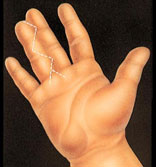
In a typical syndactyly, two fingers are fused together. The surgeon often uses zig-zag incisions to separate the fingers, creating triangular skin flaps.
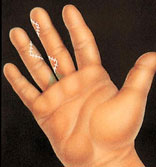
Skin flaps cover most of the exposed areas between the fingers. Skin grafts are used to fill the shaded areas at the base of the fingers.






